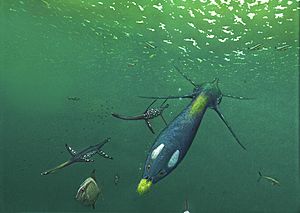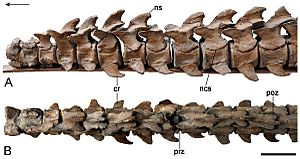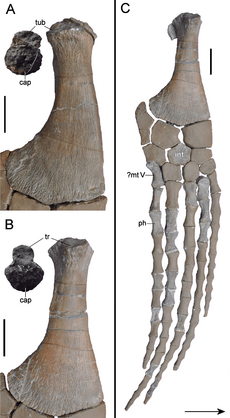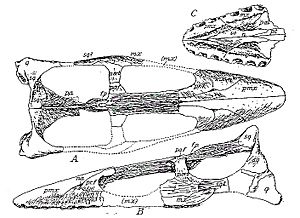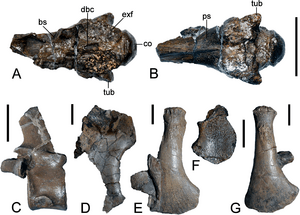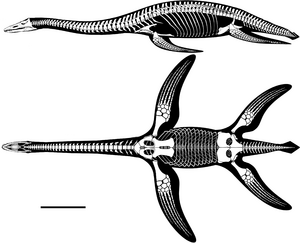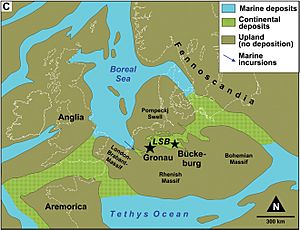Brancasaurus facts for kids
Quick facts for kids Brancasaurus |
|
|---|---|
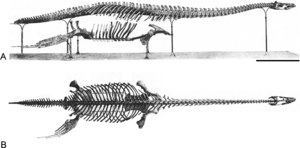 |
|
| Holotype specimen | |
| Scientific classification | |
| Genus: |
Brancasaurus
|
| Species: |
brancai
|
| Synonyms | |
|
|
Brancasaurus (which means "Branca's lizard") was a type of plesiosaur. Plesiosaurs were large, marine reptiles that lived in the time of the dinosaurs. This one lived in a freshwater lake in what is now Germany. This was during the Early Cretaceous period.
Brancasaurus had a long neck and a small, pointed head. It looked a bit like Elasmosaurus, but it was smaller. Brancasaurus was about 3.26 metres (10.7 ft) (about 10.7 feet) long. Its neck bones had special "shark fin"-shaped spines. The main type of Brancasaurus is called Brancasaurus brancai. It was named in 1914 by Theodor Wegner. He named it after a German paleontologist named Wilhelm von Branca. Another plesiosaur, Gronausaurus wegneri, is probably the same animal. Scientists first thought Brancasaurus was an early member of the Elasmosauridae family. But now, many think it's part of the Leptocleididae family. This group includes many other freshwater plesiosaurs.
Contents
What did Brancasaurus look like?
Brancasaurus was a medium-sized plesiosaur. It grew to about 3.26 metres (10.7 ft) (10.7 feet) long. The main fossil found, called the holotype, was likely a young adult. We can tell this because some of its bones were not fully grown together.
How big was its skull?
The skull of the main fossil is 23.7 centimetres (9.3 in) (about 9.3 inches) long. It was long and narrow. Its snout, or nose area, tapered down at a slight angle. The eye sockets were about the same size as the openings behind them. A narrow ridge ran along the top of the skull. It went from the front of the snout to the back of the eye sockets.
The bones that form the forehead, called the frontal bones, made a rectangular bar. This bar separated the eye sockets. The bones around the eye, called the jugal bones, went from the bottom of the eye socket backwards. The bones at the back of the skull, called the squamosal bones, curved to form the back of the head. They had a ridge for neck muscles to attach.
Scientists also found impressions of the braincase. This showed parts of the inner ear. It also showed canals for important nerves. The lower jaw was not perfectly preserved. But it seems to have been low. The teeth were lost from the fossil. But they were first described as long and thin. They had rough ridges on their outer surfaces.
What was its backbone like?
The entire neck of Brancasaurus was about 1.18 metres (3 ft 10 in) (3.9 feet) long. It had 37 cervical vertebrae (neck bones). The main parts of these bones were wider than they were tall or long. Both ends of each neck bone were slightly curved inwards. This means they were amphicoelous. The sides of the bones were also slightly curved. Unlike many other long-necked plesiosaurs, they did not have a ridge on the side.
The neural spines on the neck bones were very special. They were shaped like shark fins, tall and triangular. There were three pectoral vertebrae where the neck met the body. These were taller than they were long. Their neural spines were rectangular and pointed slightly backwards. The neck and pectoral bones had deep holes. These holes allowed the notochord to pass through.
Brancasaurus had 19 dorsal vertebrae (backbones). These were similar to the pectoral bones. They were taller than they were long. But their neural spines were even taller than the main part of the bone. The ribs were rounded. Some had a prong-like part at the top. Underneath, there were at least ten pairs of gastralia (belly ribs). Each belly rib got thinner towards the sides.
There were three sacral vertebrae (hip bones). These were similar but had smaller, more oval-shaped ribs. The first hip rib pointed more outwards and backwards. The fossil originally had 25 tail bones (caudal vertebrae). Now, 22 are still there. The last few tail bones were partly fused together. The tail ribs were flat and triangular.
What about its flippers and limb bones?
The interclavicle was a large plate-like bone. It had a smooth top and a groove on the bottom. The scapulae (shoulder blades) had shelves on each side. This is a feature seen in leptocleidids and polycotylids. The two coracoids (chest bones) curved outwards. They met at their ends, forming a hole in the middle.
The pubes (front hip bones) formed a somewhat rectangular shape. The ischia (back hip bones) were flat and triangular. Where the pubes and ischia met, they curved inwards. This formed two rounded openings. These openings were connected in the center by a small diamond-shaped hole. This is also seen in Futabasaurus. The ilia (upper hip bones) were rod-shaped and bent. They were flattened into a fan shape at the top.
The humeri (upper arm bones) were about 24 centimetres (9.4 in) (9.4 inches) long. They were oval-shaped. Their front edges curved in an S-shape. This is also seen in Leptocleidus and other plesiosaurs. The only femur (thigh bone) found is 21.5 centimetres (8.5 in) (8.5 inches) long. It was curved on one edge and straight on the other. The other long bones of the limbs are missing. The 14 preserved phalanges (finger/toe bones) were long and hourglass-shaped.
Did it have soft tissue?
It seems that soft tissue was found with the fossil. But it was removed during preparation. There was a layer of smooth, layered calcite covering the limbs and body. Some thought this was preserved skin. Also, some sediment in the belly area might have been gut contents. This could have included gastroliths (stomach stones) and digested bones. However, these samples are no longer available. So, we can't be sure about these ideas.
How was Brancasaurus discovered and named?
The main fossil of Brancasaurus brancai is stored at the University of Münster. Its number is GPMM A3.B4. It was found in July 1910 by workers in a clay pit. This pit was near the city of Gronau, North Rhine-Westphalia in Germany. The workers used pickaxes to dig it out. This damaged the fossil. For example, the pubis (hip bone) was broken into 176 pieces.
Paleontologist Theodor Wegner later collected small pieces left behind. In 1928, he described the fossil in detail. The skeleton is quite complete. It includes parts of the skull, most of the backbone, ribs, belly ribs, parts of the shoulder and hip bones, both upper arm bones, one thigh bone, and foot bones. Over time, some parts have been lost. These include skull pieces, teeth, and some limb bones. A wax model of the brain of the fossil is stored in the Naturmuseum Senckenberg.
The clay pit where the fossil was found is part of the Isterberg Formation. This formation belongs to the Berriasian age of the Cretaceous period. Another, less complete fossil of a young Brancasaurus was also found. It includes hip bones and some backbone parts. This fossil is from a slightly older rock layer. Other possible Brancasaurus bones have been found in other areas of Germany.
What about other names for Brancasaurus?
Another fossil, GPMM A3.B2, includes teeth, jaw parts, skull parts, backbone, ribs, and limb bones. This fossil was first thought to be Brancasaurus. But in 2013, Hampe named it a new genus and species: Gronausaurus wegneri. This fossil was found about 8 metres (26 ft) (26 feet) higher in the rock layers than the Brancasaurus fossil.
Later studies showed that this fossil, which was from an adult, was almost the same as the Brancasaurus fossil. There were only small differences. These differences might be due to individual variation or age. This means Gronausaurus wegneri is probably the same as B. brancai. So, Gronausaurus is a synonym of Brancasaurus.
Some other plesiosaur names, like Plesiosaurus limnophilus and P. kanzleri, were given to fossils from the same area. But these fossils are not very clear. Many have been lost. So, they are now considered nomina dubia (doubtful names). Some scientists think they might also be Brancasaurus remains.
At first, Brancasaurus was placed in the Elasmosauridae family. But scientists noticed it had a shorter neck and a narrower head. It also had unique skull and backbone features, like the "shark fin"-shaped neural spines. These were different from other elasmosaurids known at the time. Many studies later considered Brancasaurus to be an early member of the Elasmosauridae.
However, some scientists have different ideas. Theodore E. White even created a new family, Brancasauridae, for Brancasaurus and some other plesiosaurs.
Another idea is that Brancasaurus belongs to the Leptocleididae family. This group includes Leptocleidus, Vectocleidus, Umoonasaurus, and Nichollssaura. This idea has become more popular. Studies have found many features that link Brancasaurus to the Leptocleidia group.
A study in 2016 by Sachs and others found two possible places for Brancasaurus in the plesiosaur family tree. It could be within the Leptocleididae. Or it could be a close relative to a group that includes both Leptocleididae and Polycotylidae. The study concluded that we don't have enough information yet to be completely sure. This is because Brancasaurus has a mix of features from different plesiosaur groups.
|
Idea A: Brancasaurus is in the Leptocleididae family (based on Benson and others, 2013)
|
Idea B: Brancasaurus is outside the Leptocleididae family (based on Benson & Druckenmiller, 2014)
|
What was Brancasaurus's home like?
Brancasaurus lived in the Bückeberg Group area. This was likely a large freshwater lake. Rivers from the surrounding hills flowed into it. This lake was sometimes connected to the Boreal Sea through a passage to the west.
Over time, the lake grew larger. It also became more brackish, meaning it had more salt. This happened as the sea level rose. The sediments found probably came from the bottom of the lake, where there was little oxygen. It is thought that plesiosaurs like Brancasaurus were preserved after they sank to the bottom.
Besides Brancasaurus, many other animals lived in the Bückeberg Group area. These included:
- Bivalves (shellfish)
- Sharks like Hybodus and Lissodus
- Fish like Caturus, Lepidotes, and Callopterus. Brancasaurus likely hunted these fish near the surface.
- The turtle Desmemys
- Crocodilians like Goniopholis and Theriosuchus
- Dinosaurs like the theropod Altispinax and the armored Hylaeosaurus
- Other animals like pterosaurs (flying reptiles) and other types of dinosaurs.
Images for kids
See also
 In Spanish: Brancasaurus para niños
In Spanish: Brancasaurus para niños


